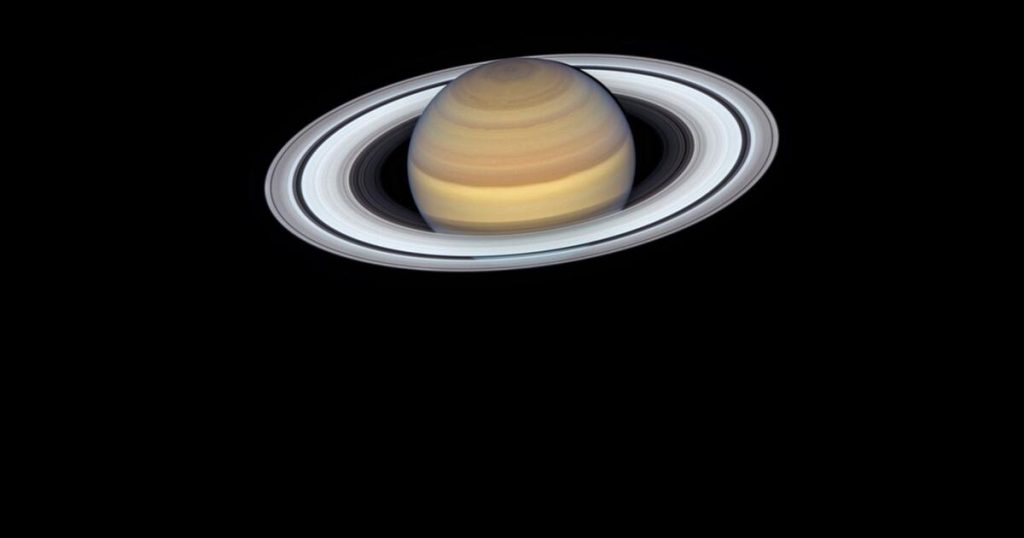Updated on 09/15/2022 at 8:30 PM
- Saturn is also considered the planet of the rings. But how exactly did that happen?
- The researchers have now presented a new theory.
- They came to this explanation through another peculiarity of the second largest planet in our solar system.
According to one study, the destruction of the Moon 100-200 million years ago led to the formation of Saturn’s rings. This also explains the strikingly large inclination of the axis of rotation planets. US researchers came to this conclusion based on a new analysis of data from the Cassini space probe and computer simulations.
In order to confirm the model, however, the internal structure of Saturn must be examined more closely, the scientists wrote in the journal Science.
Read also: The result surprised researchers: the core of Saturn is much larger than assumed
Saturn’s axis of rotation “oscillates” in the same rhythm as Neptune’s orbit
Jack Wisdom of the Massachusetts Institute of Technology explains that “the angle between the equatorial plane of the planet and the plane of its orbit at 26.7 degrees is too large to occur during the formation phase of Saturn from the rotating disk of gas around the sun.” (MIT) and colleagues. Because the conservation of angular momentum ensures that the axis of rotation of any developing planet is approximately perpendicular to the orbital plane. So there must be a later reason to tilt this axis.
Astronomers have discussed an echo between Saturn and Neptune, the farthest planet in the solar system, as a possible cause for nearly two decades. Because Saturn’s axis of rotation “oscillates”–the researchers call it anticipation–in the same rhythm as Neptune’s orbit. As a result, small perturbations from Neptune accumulate over such a long period of time that what was originally a small inclination of the axis can increase to the present value.
Researchers build an improved model of the planet
However, the influence of Neptune on Saturn depends on its moons and on the exact distribution of Saturn’s internal mass. That’s where Wisdom and colleagues come in: Based on orbital data sent back to Earth by the Saturn probe Cassini—particularly during the crash of the target probe on September 15, 2017—the researchers built an improved model of the planet. And I came to a disappointing conclusion at first: so Saturn is not in the zone of resonance with Neptune, but outside.
But the team did not give up. Researchers’ idea: Saturn may have initially been in harmony with Neptune, but was then alienated by an event in that region. “So we started looking for a way to get Saturn out of Neptune’s echo,” Wisdom says.
Read also: NASA dazzles with new pictures of Jupiter that look like it was painted
Saturn must have already had another larger moon
On the basis of theoretical considerations and a large number of simulations of the planet and its moons, scientists finally came up with a solution: Saturn must originally have another larger moon. Only with this extra moon—which is said to be the size of the third-largest satellite of Gabitus—was it possible to sustain Saturn’s resonance with Neptune for so long.
But the orbits of Saturn’s moons change. In particular, the orbit of Saturn’s largest moon, Titan, is slowly moving outward. Sometime between 100 and 200 million years ago, this caused a severe disturbance to the orbit of the previous extra moon, which Wisdom and his team dubbed “Chrysalis”: in a chaotic orbit, it approached Saturn so closely that the planet’s tidal forces were torn apart. With the disappearance of Chrysalis, Saturn deviated from the echo of Neptune.
Much debris fell on the planet, eventually forming what are now known as Saturn’s rings. So this model can explain both the rings and the tilt of Saturn’s axis. However, this scenario is still highly dependent on the distribution of mass within the planet. Therefore, more accurate data from future space probes are needed to confirm the model. (ff/dpa)

“Total coffee aficionado. Travel buff. Music ninja. Bacon nerd. Beeraholic.”









More Stories
Coral Seeding: Artificial Insemination Makes Coral More Heat Tolerant
Fear, Anger, and Denial: How People Respond to Climate Change – Research
LKH Graz: Using radiation to combat heart arrhythmias